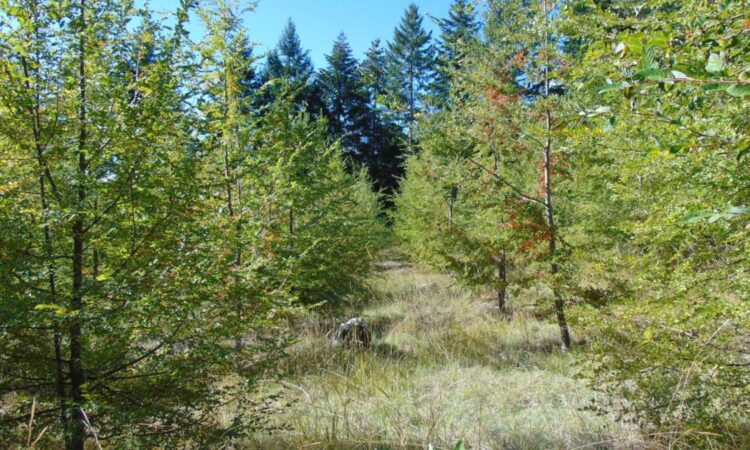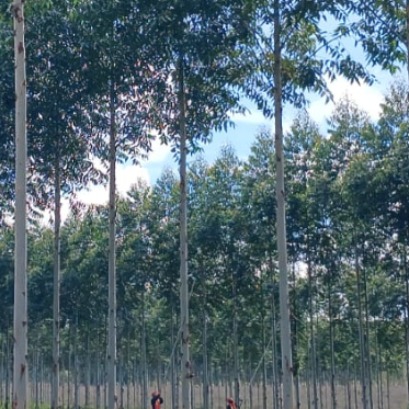
INTA Bariloche
INASE certified the first Roble Pellín seed orchard
It is a native forest species that has the best quality wood in the Andean-Patagonian Forests. The orchard was created by the INTA Bariloche forest genetics group and will provide certified seeds with superior genetic quality to regional nurseries for the production of seedlings. After 15 years, with testing and selection, the National Seed Institute (INASE) certified this first Seed Orchard of the species in our country.
The Pellín Oak (Nothofagus obliqua) is one of the native forest species with the best wood quality in the Andean-Patagonian Forests. In order to obtain seeds of certified genetic quality and origin for propagation, a team of researchers from INTA Bariloche followed the strategy of creating a "progeny seed orchard".
After 15 years, with testing and selection, the National Seed Institute (INASE) certified it as the first Seed Orchard of the species in our country.
"The registration of a forest seed orchard is the crystallization of a long process in which several researchers and technicians participate," said Mario Pastorino, a researcher in the INTA Bariloche forest genetics group, and assured that it is one of the final products of a line of work that began three decades ago for the domestication of native forest species within the framework of INTA's National Forestry Program: "for this Seed Orchard, we began with the harvest of seeds in the natural forest in 2008, and today we have obtained a plantation of seed trees established and ready to start producing seeds to project their use in the region”
The seed orchard of Roble Pellín progenies was installed in Lago Puelo, in INTA's General San Martín Forest Camp. It is a half-hectare plantation with almost 400 trees selected for their growth and resistance to late frosts.
The trees have reached a height of 5 to 7 meters and have already begun to produce seeds. They are expected to enter full production in a couple of years to provide seeds to regional nurseries.
With this seed material, seedlings can be produced to be used in commercial or ornamental plantations, outside the natural area of distribution of the species, which is focused on the province of Neuquén.
The Pellín Oak has a highly appreciated wood with a high value in the market. The purpose of the orchard is to produce seeds and make them available to nurseries in the region to make plants that are used in the production of wood or ornamentally, which represents an increasingly sought after use, since it is a species suitable for urban trees, with very showy autumn foliage.
Seed orchards are plantations of clones or progenies of selected trees with economic characteristics, which are isolated to avoid or reduce pollination from external sources of inferior quality and which are managed to harvest seeds in abundance.
According to Pastorino, the genetic improvement process made it possible to select those specimens with better characteristics than the average of the trees evaluated to guarantee that the seeds obtained also have superior genetic quality.
"The seed orchards are regular plantations, in this case with a distance of 3 x 4 meters, which facilitate management and favor crossbreeding between these superior quality specimens, a situation that does not occur in the natural forest, where these 'good' trees interbreed with any tree," said the researcher.
Likewise, he added that the regularity of the plantation, with specimens of the same age, facilitates the harvest of the seed.
The work began in 2008 with the harvest of roble pellín seeds in the natural forest, then the seedlings were cultivated in the INTA Bariloche experimental nursery and tests were carried out that allowed the materials to be evaluated within a period of 5 years.
The selection criteria were focused on the growth in height and diameter of the little trees and the response of the specimens to extreme events of late frosts was also considered.
The INASE certification provides a single regulatory code for this Seed Orchard and includes it in a catalog of "basic propagation materials" such as seed stands and seed-producing areas, as well as different types of seed orchards.
“In the catalogs of forest species, most of the basic materials listed are from productive exotic species such as pines, eucalyptus and poplars. Those of native forest species are scarce in the country and most of them were created by INTA”, pointed out Pastorino.
In this sense, Jorgelina Claverie, technical coordinator of the INASE forest species certification system, pointed out that "during the registration process in INASE, the declared information was evaluated and verified through a visit

IT MAY INTEREST YOU
 Experts cant believe it, but this tree is the oldest in the world and continues to bear fruit: it is 4,000 years old.
Experts cant believe it, but this tree is the oldest in the world and continues to bear fruit: it is 4,000 years old.
Nature keeps secrets that defy the passage of time, and one of the most surprising examples is a tree that, approximately 4,000 years old, continues to bear fruit today. This specimen has become a symbol of resistance and longevity, capable of surviving climate changes, landscape transformations and human activity itself.
 The second largest wetland in South America is located in Argentina: what is it?
The second largest wetland in South America is located in Argentina: what is it?
Argentina has national parks that place it in a unique position within South America, competing with 300 others. Which is the largest? South America is home to more than 300 national parks, but many go unnoticed. There are extensive wetlands that have been the subject of major ecological restoration projects, to coastal mountains with deep indigenous heritage. Today we tell you the case of one located in Argentina.
 Paraguay | The plantations became instruments of territorial development and the generation of decent employment, INFONA highlights.
Paraguay | The plantations became instruments of territorial development and the generation of decent employment, INFONA highlights.
Plantings in different phases, control of ants and weeds, pruning and thinning, mechanized harvest, technology applied to the field and complete integration of the production cycle were part of the CREA Forestal proposal in its Technical Update Conference – JAT Forestal 2025. The event took place on Friday, November 14, at Estancia Ñemity, located in San Juan Nepomuceno, Caazapá, where agricultural producers, technicians, contractors, students and companies in the sector met to observe the forestry business of the future in action.





















